Appearance and features
Nina Weibull rose is small but very bright. The buds bloom in large clusters, which compensate for the small size of a single rose with their volume. The flowers are semi-double, in the form of a bowl.
The buds are painted in rich crimson and crimson tones that do not change from exposure to sunlight. The decorativeness of roses is not lost from the rain. Dense buds retain their freshness until severe frost, since the variety has increased frost resistance. The variety has one drawback - a weak, almost imperceptible aroma.
Shrub variety Nina Weibul miniature, loose. There are many shoots, they grow no more than 50 cm wide. Inflorescences of 3-5 roses are formed on one shoot. The abundance of flowering depends on the quality of the pruning. The foliage on the stems is medium-sized, dark green. The branches are covered with a large number of burgundy-brown thorns.
History of origin
When crossing polyanthus, musky and hybrid tea roses, an amazing plant was obtained, adapted to frosty wintering, abundantly blooming with scarlet buds and does not require special skills and knowledge when growing.
For the first time, the progenitors of the modern floribunda rose were introduced to the eyes of gardening enthusiasts in 1903 by Peter Lambert. Work on the development of new varieties continues to this day. The floribunda class began to include specimens obtained as a result of selection that have characteristics similar to polyanthus and tea-hybrid cultures (for details about the best varieties and types of Floribunda roses, read here, and from this article you will learn the rules for the care and cultivation of a rose of this flower). One of the results of breeding work was the Nina Veibul variety.
Cultivation technology
Floribunda Nina does not involve any special growing techniques. The rose is suitable for cultivation for personal use or sale. They take care of the culture in the same way as for other members of the family of rosaceous bushes.
Choosing a place for a rose
The Nina rose should be planted in the right place, this will ensure the formation of a large number of buds, abundant flowering, and intensive development. The site should be well lit, flowers love an abundance of sunlight. Bushes do not like drafts, gusts of the north wind.
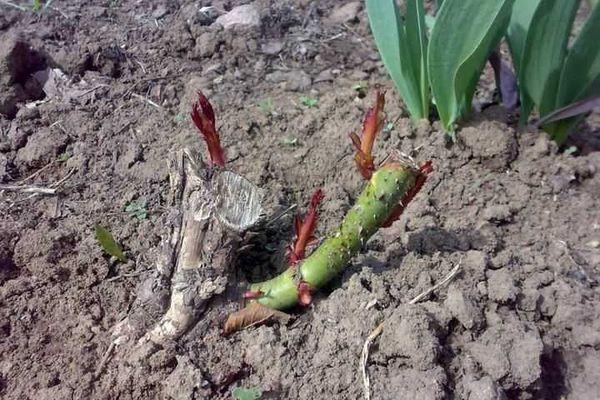
You can not plant a rose in the shade of trees, they will take away not only sunlight, but also nutrients from the soil. The place should be level, slightly hilly, since there is a danger of winds on the hills, and a lot of moisture accumulates in the lowlands. Stagnant water is dangerous due to the death of the rhizome, the development of diseases. A place where roses have previously grown for 10 years is not suitable for planting.
Required temperature, humidity and illumination
Planting a rose bush at the end of May, when the air and earth warm up to 10 degrees Celsius, there will be no night frosts. The hole is prepared in advance, with a diameter of 70 * 70 cm. The rhizome should be placed in it. The hole is filled with a mixture of sand, peat and garden soil with humus in equal proportions. Additionally, you can add bone meal, phosphorus substances to the depression.
Soil composition
The soil must be well-drained and fertile. It is worth avoiding land with a lot of salt, very wetlands. The rose takes root well in slightly acidic, well-fertilized soil or black soil. The acidity should be 5.6-7.3 pH. If the level is high, it is lowered by adding ash or lime, and raised with peat and manure.

Seedling preparation
The rhizome of the planting material is cut evenly, removing very long, rotten, broken parts. Should remain 30 cm in length. Shoots are pruned too, leaving them 35 cm long.Soak the root system in water for 1 day before planting. Add a Kornevin-type stimulant to it.
Rose planting scheme and rules
Rose bushes are planted according to the requirements below.
- A drainage layer of crushed stone with gravel is laid on the bottom of the pit. Next, there is a layer of compost and humus, combined with fertile soil. The latter will be made of garden soil, covered with a dome. The thickness of each layer should be at least 10 cm.
- If the root system is open, dip it in water for 2 hours before planting.
- When the seedling is grafted, follow the grafting site during the planting process. It is deepened into the ground by 2 cm. This will contribute to the growth of roots, improve the nutrition of the bushes.
- Water the plant abundantly at the root. If the earth settles, add it.
At the end, the root circumference of the bush is mulched with peat.
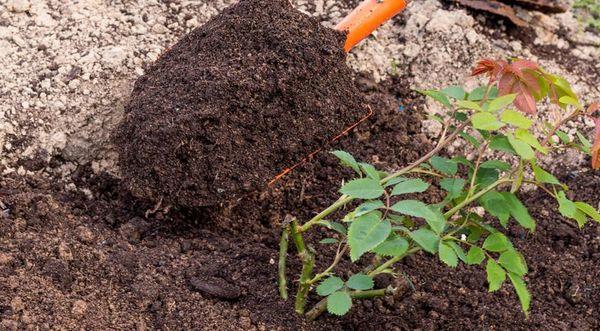
Flower propagation
Roses are propagated in several ways:
- seeds;
- cuttings;
- dividing the bush;
- budding (grafting one variety onto another).

Cuttings prepared for planting. They can be divided into parts
Gardeners often use cuttings to preserve the variety.
Detailed description
Leaves and buds are removed from the branches. Shoots are cut 20 cm long. Thorns are removed from the lower 1/3 of the cutting. The finished planting material is placed in water for a week. After the roots appear, they are deepened in a prepared planting container.
Note! In high humidity, cuttings grow faster, they are covered with scraps of plastic bottles
Features of caring for the variety of roses Nina
It is simple to care for the Nina rose, you just need to perform the following actions:
- water the bushes in a timely manner;
- process against pests, diseases;
- loosen the ground;
- make top dressing;
- trim shrubs.
They also build a shelter for roses before the cold weather.
Bush irrigation
The land in the flowerbed should be loosened without fail. The procedure allows the soil to breathe, improves its permeability. Weeding should be carried out the next day after rain, with settled water. First, destroy all weeds.
Fertilization
You need to feed the bushes on time, this will help to improve the "health" of the rose, to increase the intensity of pollen. The first feeding is carried out 10 days after the spring pruning, before the sap flow with ammonium nitrate. Before blooming, add organic fertilizer. You can use the mullein by diluting it in a 1:10 ratio. Before frost, add superphosphate and potassium salt under each bush.
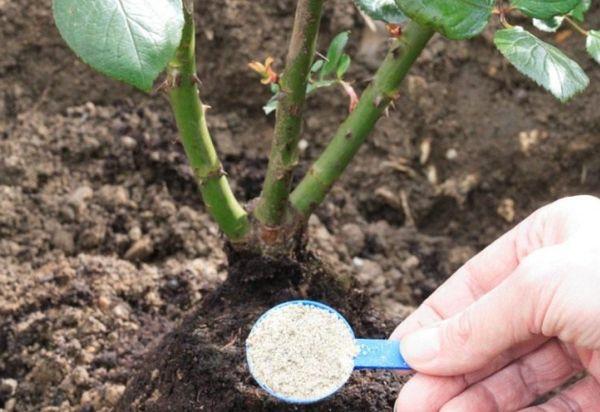
Pruning rose bushes
The rose needs regular forming-type pruning, and sanitary once a year. In the summer, you should pick off the faded buds so that new flowers form. After planting, do not let them bloom in the first year. A young bush should spend all its power on the formation of a rhizome.
Sanitary circumcision is carried out in the fall and spring. During the procedure, the damaged branches, touched by the fungus, are removed. Shoots growing inside the shrub should also be excised, as they create an unwanted shadow.
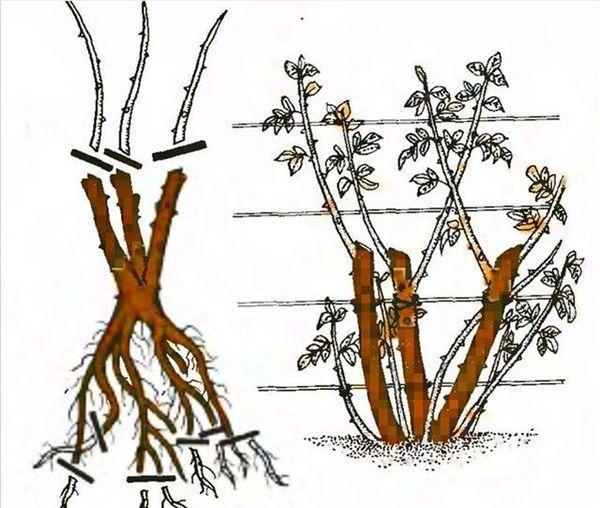
Rose transplant
Roses are transplanted from mid-April to 15 May. Move the bush with a large earthen clod to the prepared hole 70 * 70. After, leave 3 leaves on each shoot. The roots must remain intact, this is the most important aspect.
Wintering
Rose Nina is winter-hardy, but if prolonged frosts prevail in the region, it is better to cover the bushes. If the temperature does not drop more than 7 degrees of frost in winter, the shelter can be skipped. The shrub will harden more, prepare for the cold weather. They cover the rose with earth, sprinkle it on top with fallen leaves, spruce branches. Build a small frame on top and cover with non-woven material. First, remove all leaves and flower buds from the plant. Cut the stems so that their height is 40 cm.
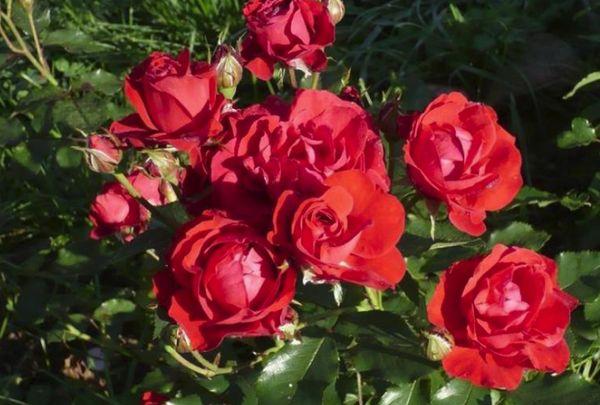
Pruning roses
Seasonal pruning is an important prerequisite for caring for your floribunda. The main one falls in the spring. All damaged stems are cut off, no more than five strong healthy branches are left on the bush.
In order for the rose to bloom early and luxuriantly, you need to carry out medium pruning, leaving 5-7 buds on each branch.
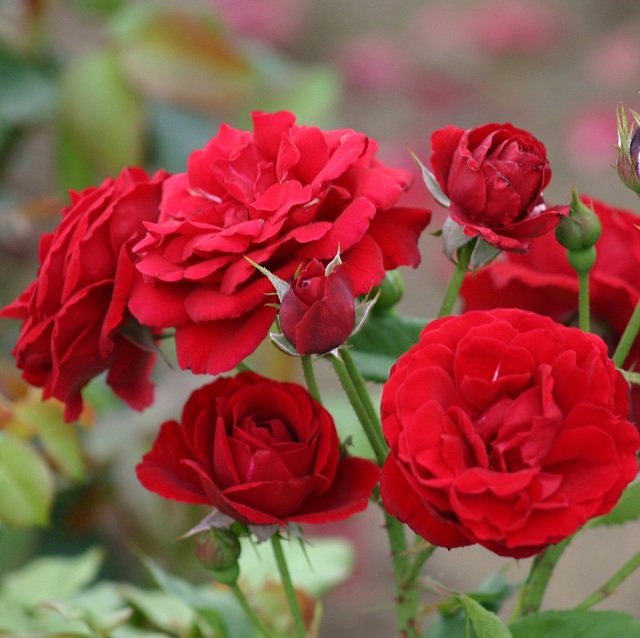
Strong pruning is essential to rejuvenate the shrub. In this case, 2-4 buds should remain on the shoot.
Throughout the summer, dried branches and faded buds are pruned, so that the Nina rose will bloom again. Autumn pruning is necessary to remove excess shoots and shorten too long shoots to give the bush the correct shape.
Growing and caring for a rose Nina Weibul
Rose variety Nina Weibul does not tolerate moisture, it is recommended to plant it on a small hill. It is necessary to choose a sunny, ventilated, but protected from drafts place.
The soil should be loose, light, at the bottom of the planting pit you need to lay out drainage from crushed stone or not coarse gravel. You also need to add a soil mixture from garden soil, humus, sand and superphosphate to the planting hole.
Diseases
Does the rose have a gray-white coating or brown balls on the sheets? Methods of dealing with the disease.
Powdery mildew
Black spots appeared on the leaves of the rose, round in shape, what to do, how to save the plant?
Black spot
The rose is sprinkled with yellow powder, the leaves and stems crack and die, how to get rid of the disease?
Rust
Is there a gray bloom on the rose? This is a gray rot that needs to be removed as soon as possible.
Gray rot

It is required to choose soil with neutral acidity - 5.6-7.3.pH. Provided that all of the above conditions are created, the variety will grow successfully and rarely get sick. When planting a bush, it is necessary to deepen the grafting site by 3 cm, for the active growth of new root shoots. After planting, the plant should be watered abundantly and the trunk circle should be mulched with peat.
It is important to regularly water the shrub, the drying out of the soil has a bad effect on flowering. Watering is carried out at least once a week, more often in drought.
Before flowering, the rose needs to be fertilized with nitrogen to stimulate growth.
When a rose is actively blooming, it needs to be fed with phosphorus and potassium to saturate it with nutrients. In the first year after planting, you should not allow the bush to bloom; when buds appear, they must be removed.
In August, it is recommended to leave a few buds that will bear fruit. Thanks to this, the plant will get stronger and the next season it will bloom in full force. In the spring, before the buds appear, the perennial must be cut for sanitary purposes, old and dry shoots must be removed.
Flowering forms on young stems, so branches that are more than 2 years old need to be removed. Without these rules, the rose will not bloom continuously. To rejuvenate the plant, the maximum pruning is carried out; no more than 4 buds are required to be left on the bush.
In the fall, you also need to do pruning, remove weak and diseased shoots. Pruning makes the rose easier to cover for the winter. In the summer, it is necessary to cut off dried buds so that flowering does not stop.
We must not forget about loosening the soil 1-2 days after watering. Mulching with peat will reduce the amount of weed. It is necessary to weed the site. Despite the fact that the variety is resistant to diseases, it is recommended to periodically carry out preventive measures against fungus and insects.
Pests
Microscopic spiders have appeared on the plant, and the rose is gradually covered with cobwebs, what should I do?
Spider mite
Are small green insects destroying your rose? Effective methods of pest control.
Green rose aphid
Caterpillars have appeared on the rose, which twist the leaves of the plant, how to deal with the pest
Rose leaf roll
Flat cones appeared on the shoots of a rose or on the underside of the foliage, how to deal with the pest
Rosaceous scale insect
In regions with severe winters, the rose needs to be covered for the winter. It is necessary to huddle the roots in order to avoid their freezing.
Rose use options
Rose Nina Weibul is suitable for any planting and is combined with almost any plant. The shrub is visible from all sides of the garden with its bright buds.The culture is ideal for "alpine" slides.
The rose can be planted in flower beds, mixborders, beds and containers. Red flowers are combined with white, pink, yellow, purple hues. Nina Weibul looks great both in single plantings and next to other varieties of roses.

Useful Tips
- A seedling of the Nina Weibul variety with an open root system must be soaked in a clay “chatterbox” for at least hours before planting;
- Even the most resistant variety can contract a fungal infection in unfavorable conditions and if improperly handled. It is recommended to plant the bush in a suitable environment, to carry out disease prevention. When pruning shrubs, only clean, sanitized tools should be used. Pruners can be kept in a potassium permanganate solution because they can transmit infection from another plant;
- Rose Nina Weibul is covered with thorny thorns that can seriously injure the skin. A perennial must be handled exclusively in tight, rubberized gloves.
Pros and cons of the Nina Weibul variety
Advantages:
- Bright, small roses blooming with tassels;
- Continuous flowering;
- Unpretentious care;
- Increased frost resistance;
- High endurance to diseases;
Disadvantages:
- Almost no aroma;
- There are many thorns on the shoots;

Growing a flower, how to plant it in open ground
In order for the plant to develop well, it must be planted, fed, protected from frost on time.
In what form is the landing
In a permanent place, pre-grown seedlings are placed. They should form a full-fledged root system, and new buds should appear.
What time is the boarding
Although the variety is cold-resistant, the bush takes time to grow stronger. Planting dates depend on the region: in any case, the soil should warm up to + 10 ° C. Planting is allowed in autumn, 3-4 weeks before the onset of cold weather. The plant needs to take root before severe frost.
Important! At low temperatures, trace elements slowly dissolve in the soil. A bush planted ahead of time will wither, it will hurt
Location selection
For planting, it is better to choose areas with diffused light. In the bright sun, the edges of the petals will dry out faster. The variety tolerates partial shade well if it receives full lighting for 6 hours a day. The bushes are planted on the leeward side so that there are no drafts.
With a high level of groundwater, drainage is done. In low-lying, flooded areas, the rose will not grow. She likes slopes, hills.
How to prepare the soil and flower for planting
Rose Nina needs a neutral soil, with an acidic reaction of the soil, liming is carried out. The earth is carefully dug up, removing the roots of perennial weeds, flavored with humus (0.5 buckets per planting pit measuring 60x60 cm). The prepared soil is laid next to the landing site.
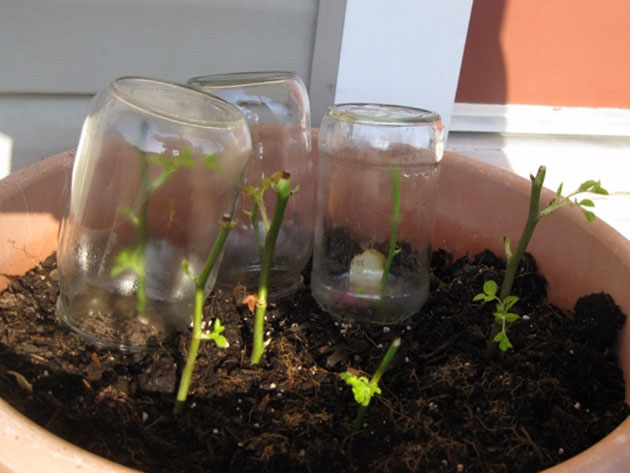
Growing seedlings at home by cuttings
The shoots of the seedling are pruned by 1/3, so that the plant quickly adapts to new conditions.
Important! Before being transferred to open ground, the seedlings are hardened: they are taken out to a cool place for several hours, gradually increasing the time interval. Planting procedure step by step
Planting procedure step by step
- drainage is laid at the bottom of the planting pit with a layer of up to 10 cm (broken brick, gravel or expanded clay);
- in the center, a mound is made of prepared soil 10 cm high, the roots of the seedling are spread on it;
- sprinkle the root system with the remaining prepared soil so that the root collar is at a depth of 3 cm;
- the soil is well watered (at least 2 buckets of water per plant), crushed so that there are no voids at the roots;
- carry out mulching with dry peat or humus.
Note! The earthen lump of purchased plants is broken, the roots are immersed in a clay mash (water, clay, chalk) for several minutes. Roses are not transplanted by the transshipment method.
Landing features
The advantages of Nina Weibull floribunda roses include high frost resistance, long and abundant flowering, as well as resistance to the most common diseases of flowering crops and absolute ease of care. However, to obtain abundant flowering rose bushes, you must follow the rules for planting seedlings:
- young plants are best planted in the spring, setting aside a place protected from drafts and well lit throughout the day for planting;
- the root system of this rose variety is characterized by good development, which requires the preparation of a fairly spacious planting pit;
- it is optimal to fill a pre-prepared planting pit with a nutrient mixture based on the same amount of garden soil, sand, humus and peat with the addition of a small amount of phosphate fertilizers and bone meal;
- grafted seedlings of the garden rose Nina Weibull must be placed correctly in the planting pits;
- the grafting site must be buried two centimeters into the ground, which helps to activate the formation of additional roots and improve plant nutrition.
After planting, watering, mulching of the soil and shading of the seedlings from the scorching sunlight are carried out.
Varietal characteristics
Bred over 50 years ago in Denmark, nina weibull is well known today in our country. They are fairly compact rose bushes with bright dark red flowers. The height of the bushes is 70-90 cm, the width is 50-55 cm. The flowers are terry, bowl-shaped, with a diameter of 5-6 cm, collected in clusters of 5-15 buds, sometimes this number reaches 30. The leaves are leathery, dark green, shiny.
The advantages of this rose include:
- frost resistance;
- resistance to fungal diseases (powdery mildew, black spot);
- abundant, long flowering;
- unpretentious care.
The disadvantages include:
- the presence of thorns on the shoots;
- lack of aroma.
The variety fully justifies the name floribunda - "profusely flowering", since the culture blooms profusely all season until frost, forming lush inflorescences with a large number of buds. In addition, nina floribunda flowers do not fade in the sun and are not afraid of torrential rains.
The advantages and disadvantages of the bush
Nina Weibull has a number of positive and negative qualities. Familiarization with them will help you decide whether to grow Scandinavian flowers or not.
| pros | Minuses |
| Increased resistance to low temperatures | Abundance of thorns |
| Low susceptibility of the bush to black spot and powdery mildew | Lack of aroma |
| Mass planting of bushes is possible, contributing to the flowering of roses at the same height | |
| Easy adaptation to different growing conditions |
Blooming rose
The variety is incredibly resistant to rain, flowers do not fade in the scorching sun. This allows the plant to bloom continuously throughout the season. The first buds form in mid-June, after which the abundant bloom lasts until November. In order for the variety to produce beautiful, rich scarlet flowers every year, they resort to feeding. A medium-sized bush ceases to form after transplanting 1 season. Roses look great when decorating rose gardens, garden areas design. Terry flowers with a diameter of 5 cm, are collected in inflorescences of 5 pieces.
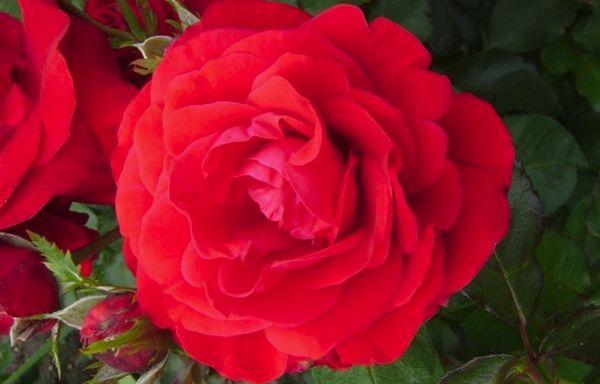
External parameters of the bush
Medium vigorous shrub grows 75 cm high. Leaves are dark green in color, glossy surface. The stems are covered with many thorns. The shrub is compact, branched, no more than 0.5 meters in width. Up to 5 buds grow on one branch.
Planting a rose Nina Weibull
Despite the fact that floribunda is an unpretentious plant, it is still worth adhering to certain rules when planting. First of all, you need to decide on a place for planting a Nina Weibull rose. It should be lit throughout the day, but so that the sun's rays touch the flower in the morning and evening, and in the daytime do not burn the petals.
It is better to grow a rose on a hill in order to avoid stagnant water in the place of growth.The area with just planted beauty should be ventilated and protected from drafts and wind.
It is better to plant a flower at the end of May so that the earth has time to warm up. Planting process:
- A spacious pit is being prepared in which the roots can freely settle.
- Lay a drainage layer of small crushed stone or gravel on the bottom.
- Fill with soil mixture from garden soil, humus, sand and peat. For the mixture, use all ingredients in equal amounts.
- Pour garden soil, 10 cm thick, with a slide.
- Dip a seedling with an open root in a clay mash for 5-10 minutes or put it in water for 1.5-2 hours.
- Place the plant in the hole. The grafting site should be 2 cm below the soil surface.
- Fall asleep, water the young bush under the root.
- If the soil settles, add more.
- Mulch around the bush using peat.
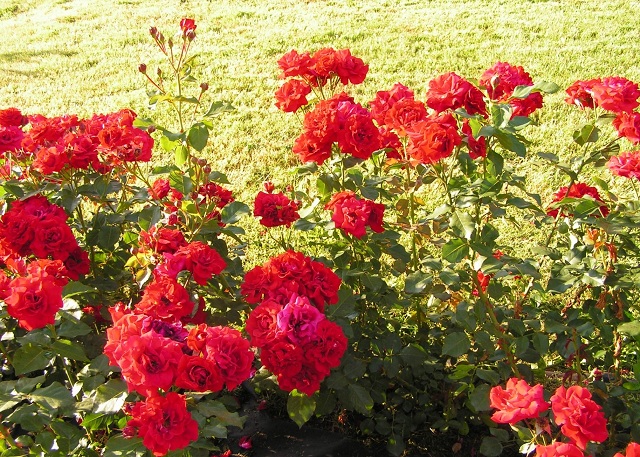
Rose propagation methods
Rose Nina is widely propagated vegetatively, following the algorithm below.
Select well-formed specimens, cut cuttings - 10 cm long
Make the lower cut at a slope of 45 degrees, the upper cut parallel to the ground.
If there are green leaves on the stem, remove them, also remove all thorns.
Treat the lower part of the cutting with a biostimulating solution.
When placing planting material in the ground, keep a distance of 15-25 cm.
When covering the petioles with foil, it is important to take into account that it should not touch them. Remove it regularly, before watering and airing.
You can also use seeds in this way:
- clear the selected planting material from the pulp, place between 2 cotton pads dipped in hydrogen peroxide;
- place the seedling in a plastic bag in the refrigerator;
- if the seeds become moldy, dispose of them, replace the old cotton pads with new ones;
- in 1.5-2 months, the first shoots will appear, which serves as a signal for the distribution of seedlings in separate containers.
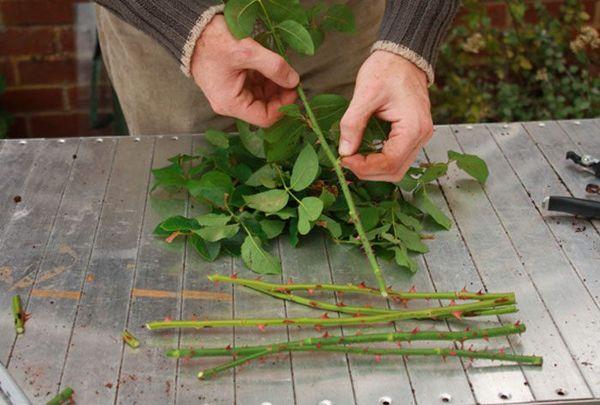
In the future, provide the young plant with 10 hours of illumination. It helps to accelerate development.
Rose Care Nina Weibull
Floribunda rose Nina Weibull is undemanding to care, but to ensure abundant and long-lasting flowering, you need to take care of it
It is important to water the plant regularly every 7 days. In hot weather, more often, the main thing is to prevent the earth from drying out
Every year, twice a season, it is necessary to feed the flower. In spring, nitrogen fertilization is applied. Must be done before the buds appear. In summer, the rose needs to be fed with phosphorus and potassium fertilizers, which will help stimulate the quality of flowering.
In the first year after planting, do not allow the plant to bloom by cutting off the buds that are ready to bloom. In August, leave 1-2 flowers on each stem to ripen the fruits. Thanks to this, the rose will grow stronger and give an abundance of flowers next year.
It is also important to loosen the soil around the bush so that air flows better to the root system and oxygenates the roots. It is imperative to get rid of the weeds


